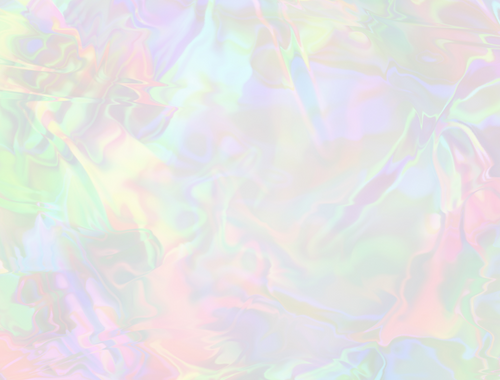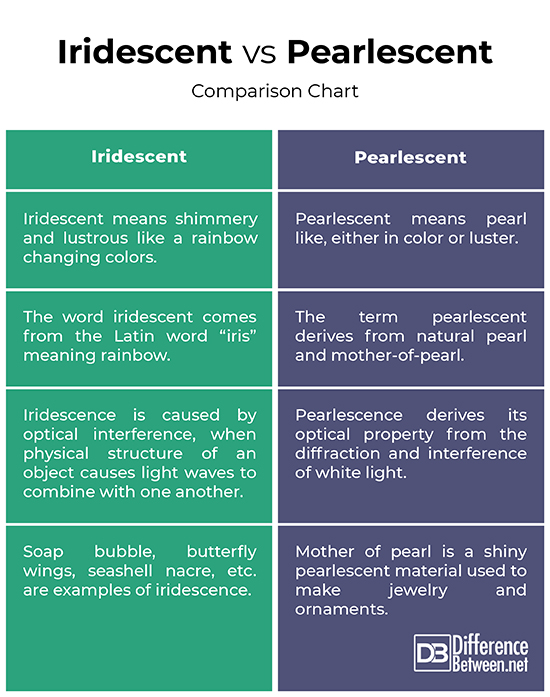Difference Between Iridescent and Pearlescent
The sensation of color is complex. And what makes it so complex is that human eye does not limit itself in detecting a single wavelength of visible light; but rather a wide range of wavelengths. Perception of a scene involves multiple variables. So, sensation of a color involves not just the factors of object coloration but also surface gloss. This ability to change colors has long intrigued people. In that context, iridescence is one such phenomenon that seems to change color with different angles of view, which is fascinating. Pearlescence is yet another related effect which is often used to describe certain paint finishes, primarily in the automotive industry. But are the two phenomena same? Let’s take a look.

Iridescent
Iridescence refers to a lustrous rainbow-like play of colors on certain surfaces that seem to gradually change color in different lighting conditions and at different angles. Iridescent means something that exhibits iridescence. For example, a soap bubble seems to contain a wealth of changing color like a rainbow. And why is that? The light partially reflects off a watery surface, and the wall of a soap bubble is like a thin film of water sandwiched between two layers of soap. So, when light hits the surface of the soap bubble, some light is reflected while some light goes through and seen as specific colors. The optical effect due to light scattering has been utilized in iridescent pigments. Iridescence can also be seen in butterfly wings, beetle shells, mallard ducks, and more.

Pearlescent
Pearlescent refers to anything that exhibits an iridescent luster that resembles that of a pearl, having a pearly luster or sheen. It means a surface that seems to shine with different colors. Pearlescent pigments are best known as effect pigments because they have this unique property of Pearlescence as well as color. These pigments are partially translucent formed by depositing titanium dioxide or iron salts onto mica with metal oxide layering. The pearl like luster comes from different optical phenomena than those involved in the production of color. The colors produced from a pearlescent pigment stem from the constructive interference of light from reflections at internal boundaries within each pearlescent pigment. Pearlescent pigments exhibit a unique optical property which gives them their ability to display multiple color effects; the ability to show two different colors when viewed from two different angles.
Difference between Iridescent and Pearlescent
Appearance
– Iridescent means something that exhibits iridescence. The word iridescent comes from the Latin word “iris” meaning rainbow. When you say iridescent, you mean lustrous, brilliant, or anything that gives off a brilliant sheen like a soap bubble. Pearlescent, on the other hand, means pearl like, either in color or luster. The term pearlescent derives from natural pearl and mother-of-pearl. It refers to anything that exhibits an iridescent luster that resembles that of a pearl, having a pearly luster or sheen.
Phenomenon
– The state of being iridescent suggests a display of lustrous, rainbow like colors, exhibiting a play of changeable colors in different lighting conditions and at different angles. Iridescence is caused by optical interference that is when physical structure of an object causes light waves to combine with one another. Pearlescence derives its optical property from the diffraction and interference of white light. The pearl like luster comes from different optical phenomena than those involved in the production of color.
Iridescent vs. Pearlescent: Comparison Chart

Summary
Iridescent refers to a lustrous rainbow-like play of colors on certain surfaces that seem to gradually change colors in different lighting conditions and at different angles. It’s an optical phenomenon that exhibits luminous colors that have the ability to manipulate colors when subjected to different lighting conditions. Pearlescent means pearl-like, either in color or luster, like mother-of-pearl. The phenomenon is quite similar to iridescence that derives its optical property from the diffraction and interference of white light.
Are pearls iridescent?
Basically all gem-quality pearls are almost iridescent and they derive optical property from the diffraction and interference of white light – a characteristic that resembles the shimmer effect seen on a soap bubble.
What is the difference between iridescent and opalescent?
The state of being iridescent suggests a display of lustrous, rainbow like colors, exhibiting a play of changeable colors. Opalescent, on the other hand, means something that is white like an opal that reflects light and changes color. This optical property is displayed by the mineraloid gemstone opal.
What is the difference between iridescent and holographic?
Both the terms are related to light. While iridescence is a naturally occurring phenomenon, holographic is virtual representation of three dimensional images created by the interference of light that reflect a physical structure.
Is pearlescent the same as iridescent?
Pearlescent means pearl like, either in color or luster. Iridescent means shimmery and lustrous and it’s an optical phenomenon that seems to change colors in different angles and lighting conditions. So, both are not the same.
- Difference Between Caucus and Primary - June 18, 2024
- Difference Between PPO and POS - May 30, 2024
- Difference Between RFID and NFC - May 28, 2024
Search DifferenceBetween.net :
Leave a Response
References :
[0]Calderon, Ana Victoria. Creative Watercolor and Mixed Media: A Step-by-Step Guide to Achieving Stunning Effects--Play with Gouache, Metallic Paints, Masking Fluid, Alcohol, and More! Massachusetts, United States: Quarry Books, 2021. Print
[1]Johnston-Feller, Ruth. Color Science in the Examination of Museum Objects: Nondestructive Procedures. Los Angeles, United States: Getty Publications, 2001. Print
[2]Segal, David. Materials for the 21st Century. Oxford, United Kingdom: Oxford University Press, 2017. Print
